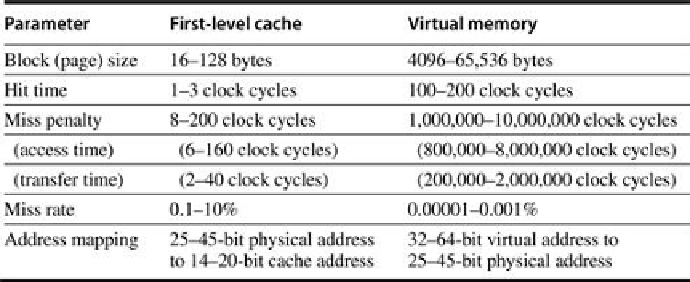Hardware Reference
In-Depth Information
Several general memory hierarchy ideas from
Chapter 1
about caches are analogous to vir-
tual memory, although many of the terms are different.
Page
or
segment
is used for block, and
page fault
or
address fault
is used for miss. With virtual memory, the processor produces
vir-
tual addresses
that are translated by a combination of hardware and software to
physical ad-
dresses
, which access main memory. This process is called
memory mapping
or
address transla-
tion
. Today, the two memory hierarchy levels controlled by virtual memory are DRAMs and
magnetic disks.
Figure B.20
shows a typical range of memory hierarchy parameters for virtual
memory.
FIGURE B.20
Typical ranges of parameters for caches and virtual memory
. Virtual
memory parameters represent increases of 10 to 1,000,000 times over cache para-meters.
Normally, first-level caches contain at most 1 MB of data, whereas physical memory contains
256 MB to 1 TB.
There are further differences between caches and virtual memory beyond those quantitative
ones mentioned in
Figure B.20
:
■ Replacement on cache misses is primarily controlled by hardware, while virtual memory
replacement is primarily controlled by the operating system. The longer miss penalty
means it's more important to make a good decision, so the operating system can be in-
volved and take time deciding what to replace.
■ The size of the processor address determines the size of virtual memory, but the cache size
is independent of the processor address size.
■ In addition to acting as the lower-level backing store for main memory in the hierarchy,
secondary storage is also used for the file system. In fact, the file system occupies most of
secondary storage. It is not normally in the address space.
Virtual memory also encompasses several related techniques. Virtual memory systems can
be categorized into two classes: those with fixed-size blocks, called
pages
, and those with
variable-size blocks, called
segments
. Pages are typically fixed at 4096 to 8192 bytes, while seg-
ment size varies. The largest segment supported on any processor ranges from 2
16
bytes up to
vide code and data.

Search WWH ::

Custom Search